Woodpeckers are one of the wood trees saviors, cleaning the tree trunks from insects, but this bird can be a real disaster for homeowners. Once a woodpecker settles in a wooden rooftop, attics, fence, or a pole, homeowners will struggle from extreme noise and potholes that are quite hard to fix.
There are various ways of effective woodpecker removal that are useful and humane, as killing species is not only banned but also is inhumane. Thus, let’s study these birds, their habitat, signs of their infestation, and how to get rid of woodpeckers invading your garden and housing.

How to Identify Woodpecker Infestation
To effectively deter woodpeckers from house and yard, let’s observe the most common species, their habits, feeding, and nesting preferences. Thus, it is possible to effectively identify an infestation, their nests, feeding sources, and effectively solve the woodpecker problem.
Common species
As a bright representative of the Picidae family, woodpeckers are found in all parts of the world. The only exception is Australia, New Zealand, Madagascar, New Guinea, and polar territories. There are about 17 woodpecker species in North America, with over 200 species spread globally. Let’s study the most common species.
Downy woodpecker
The downy woodpecker is one of the smallest Northern American species. It reaches only 6-7 inches height and has white and black feathers with a long white vertical stripe in the middle of their back. Males can be recognized by a red nape patch. They prefer to live in parks, orchards, or open woodlands, feeding on seeds, berries, and small insects that cannot be reached by their bigger relatives.
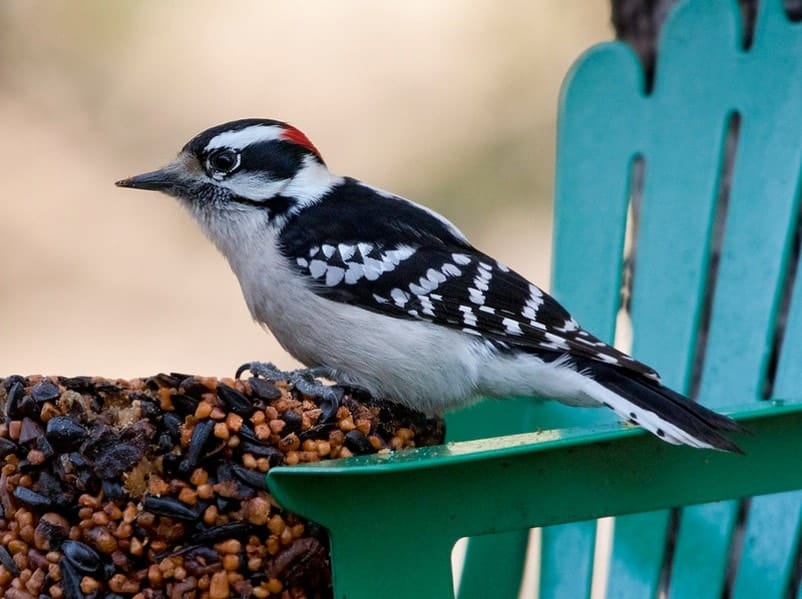
Red-headed woodpecker
The red-headed woodpecker population has seriously decreased over the last decades. Adult representatives of this species have a crimson head, wide white wings and belly, and black back. Growing about 7-9 inches, they live in woodlands, near pine plantations, swamps, and river bottoms. They feed on wood-boring insects and nuts, collected in the autumn.
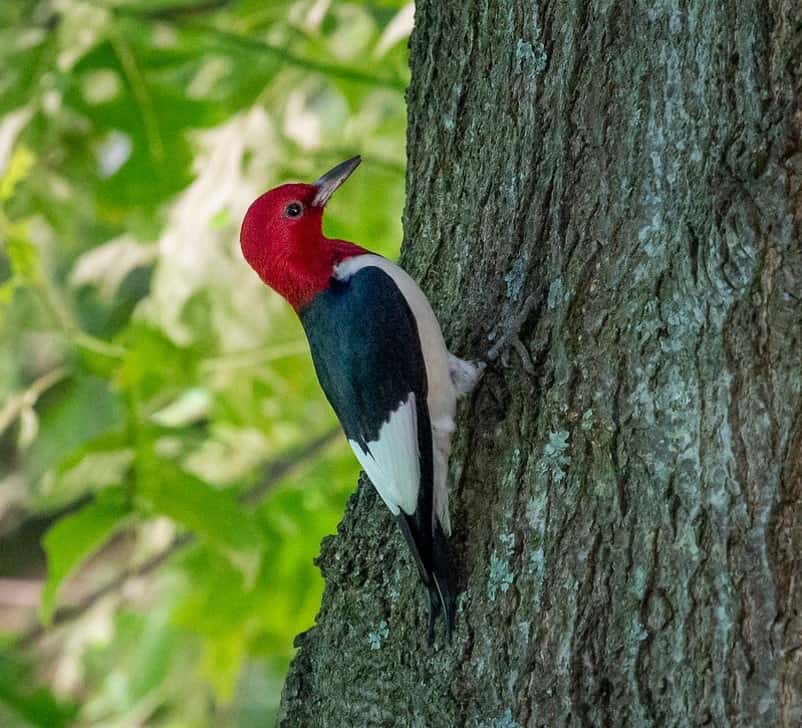
Hairy woodpecker
Hairy woodpeckers look similar to Downy woodpeckers, but are slightly bigger – they grow about 8-10 inches and have a longer bill. These birds live in orchards, parks, and mature forests, eating berries, buts, and wood-boring insects.
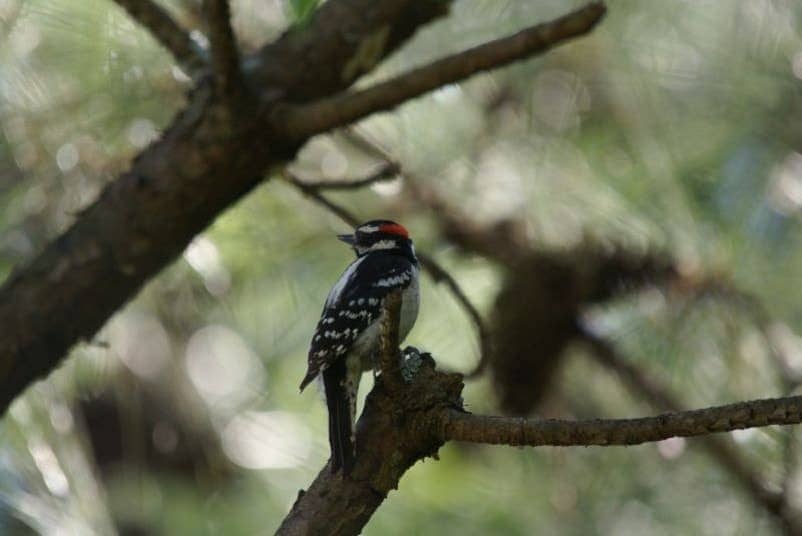
Yellow-bellied woodpecker
Yellow-bellied woodpecker or sapsucker is widespread in Eastern forests and is the only migratory woodpecker species in North America. These birds have a black and white body with a white patch on their wings, with red crown and throat for males and white throat for females.
They prefer to eat sap, as well as berries and insects. There are also red-naped, red-breasted, and Williamson’s sapsuckers spread all over the US.
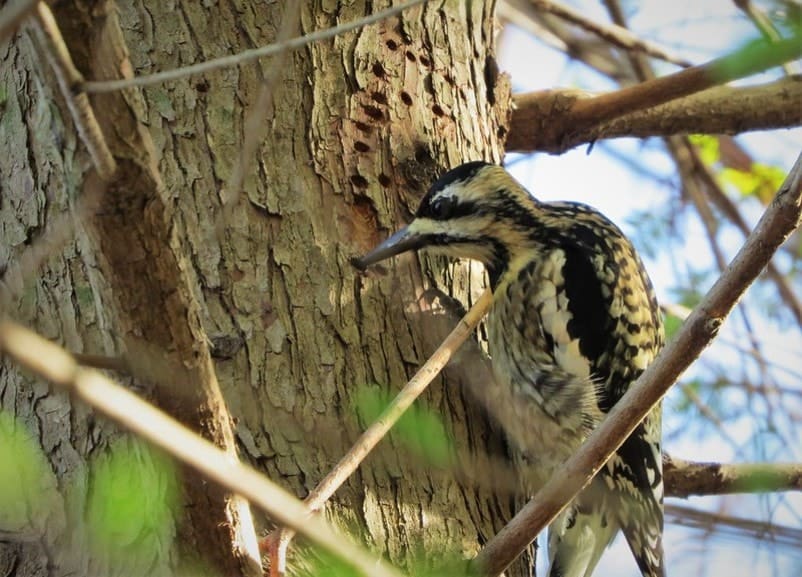
What attracts woodpecker to your home
To find out the most effective ways of repelling woodpeckers, it is essential to understand why do woodpeckers like to hammer on houses at first sight. There are several main reasons why woodpeckers hammer on houses:
-
Nesting
A lot of woodpeckers start to build their nests in the house sidings, poles, or rooftops at the start of the breeding season: from late April till the end of May. They will create one big round hole. Thus, in case you want to eliminate woodpeckers from your house, do it prior to or after this season.
-
Attracting partners
Hammering on houses creates a loud noise, satisfying these birds and even helping them to attract their future mates. In case a woodpecker started hammering your house, poles, or trees in the garden in late winter-early spring, they are most likely to stop as soon as the weather gets warmer. Woodpeckers don’t drum during the food searching season.
-
Feeding
The most usual reason for these birds to attack your territory is looking for food: woodpeckers feed on insects that might leave in your siding, leaving small irregular holes. In this case, you have to get rid of the insects that woodpeckers are coming for.
-
Cache food
Woodpeckers are collecting nuts and acorns during the summer-autumn season and store them for later feeding inside the trees, but they might also choose to keep them in your siding. In this case, you will find multiple small holes, each filled with acorns.
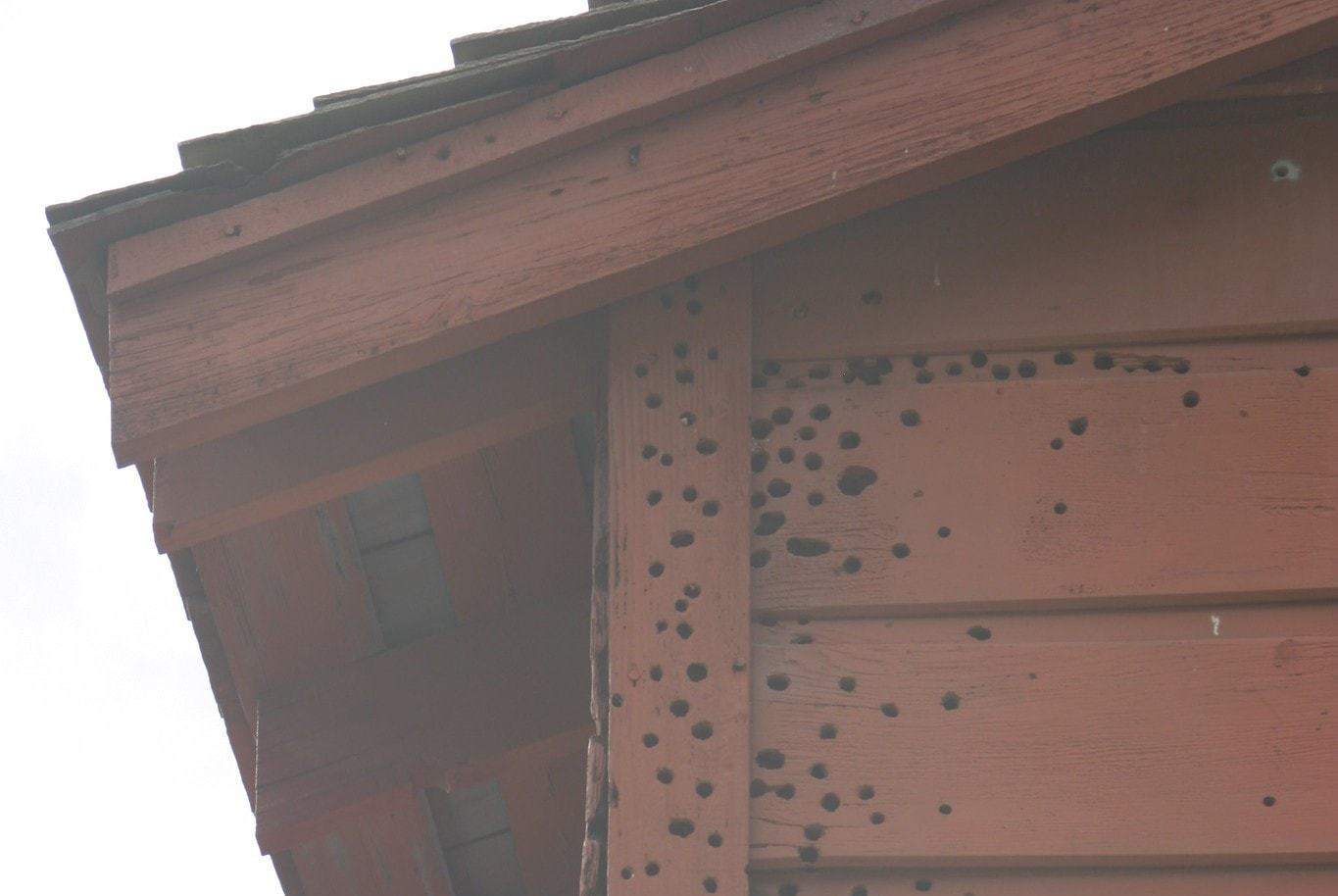
To quickly suspect the first signs of woodpecker infestation, it is essential to know the external characteristics of houses prone to woodpecker damage and how this can be solved for each type of house.
Woodpecker dangers
While not presenting direct harm to the trees, woodpecker infestation is connected with the series of potential dangers for your house and garden. The holes they make in the trees create wounds liable to diseases and insects. In extreme cases with numerous holes in the tree, the tree trunk area above the girdled bark might die.
Seeking for edible insects, woodpeckers might also attack your home, damaging siding, decks, and insulation that creates holes in the surface. The holes have to be fixed to protect your house from winds and precipitation, which is a hard and pricey job. These holes can also create a way for more insects to invade your house or make cracks in the boards, damaging the whole construction.
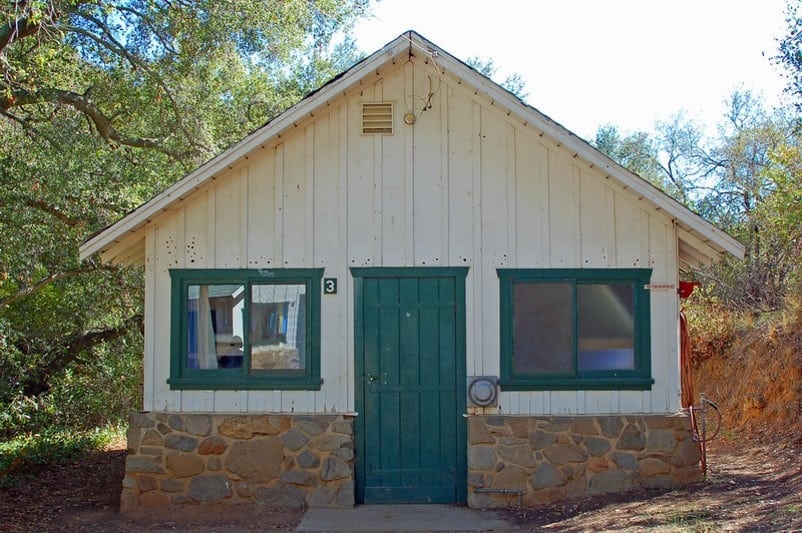
Signs of woodpecker infestation
The most evident sign of woodpecker invasion is an apparent quick tapping sound close to your house, yard, or garden. However, there are other signs that you might regard even if you don’t hear the typical woodpecker drumming.
- Feeding holes – small deep holes, that for a straight horizontal or vertical line that can be up to 4 inches long. Woodpeckers create these holes looking for edible insects
- Nesting holes – excavation holes might take from 3 to 5 cm in diameter, found near the rooftop close to the chimney or just in warmer and more isolated areas. Woodpeckers use warm and easy to drum house siding for nests, creating their upside-down L-shaped dens.
- Pairing holes – these are small drumming holes, or bigger cone-shaped depressions usually found near the windows or on the corners of external cladding. Woodpeckers can also drum on metallic surfaces (chimneys, antennas, aluminum siding) to attract potential partners during the pairing season.
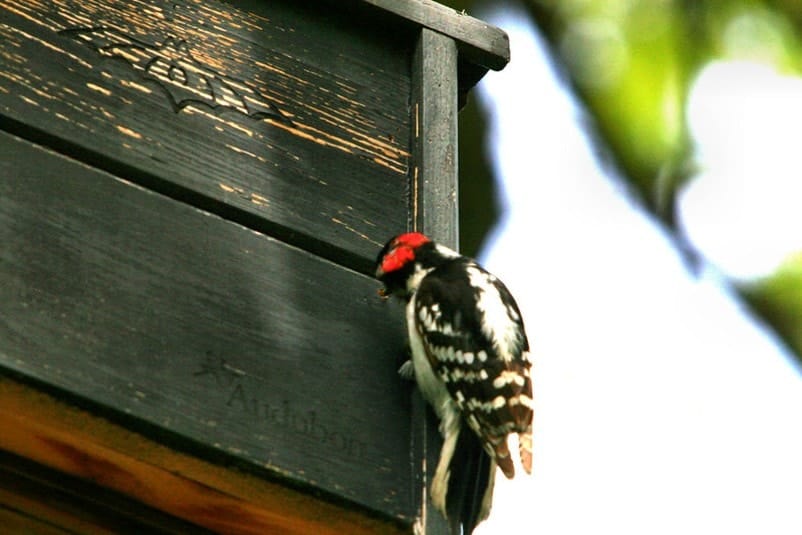
In case you have mentioned at least one of these signs of woodpecker infestation, or suspect the invasion for other reasons, check the areas they prefer most to prevent woodpecker damage to your house and garden:
- House siding;
- Roof eaves;
- Roof tiles;
- Rain gutters;
- Drain poles.
How to Get Rid of Woodpeckers: Easy Extermination Guide
Identifying the infestation of these birds is followed by the question: “How to keep woodpeckers away?” The process of woodpecker elimination is complicated as one woodpecker will attract more representatives of this species with the noise.
To solve this problem once and forever, let’s observe what to use to keep woodpeckers away, reviewing each stage of the step by step process of woodpecker removal.
Step 1: Examine your property for signs of insect infestation
If you suspect woodpeckers to invade your house or garden, start with a thorough inspection of your property. First, try to find holes that were probably made by these birds on the siding, the rooftop of your house, insect gutters, and eaves.
There, you might find the typical feeding, pairing, or nesting holes. Woodpecker nests can be found higher on the house siding or close to the chimney. In case you find the lines of small holes – woodpeckers are trying to catch insects that live inside. These holes will be found on wooden surfaces.
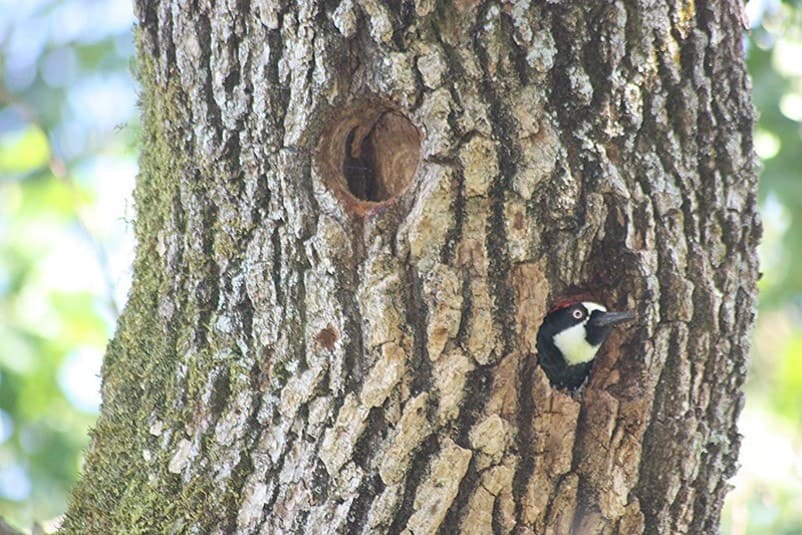
In case you have seen the signs of woodpecker infestation in your garden, start with inspecting the poles and fences that might be a perfect place for numerous drumming holes woodpeckers make to attract their partners with the loud noise.
Another great source of food is trees in your garden or nearby, which can also be used for nesting. Try to inspect all trees’ crowns that represent a quiet and isolated place, perfect for building nests. Attentively insect the tree trunks for food storage holes filled with acorns, which is a sign of prolonged woodpecker infestation.
Step 2: Remove or replace the food source (describe insecticides and bird feeders)
It is important to inspect your house for insects like ants, bees, and termites. In case woodpeckers have invaded your house in search of food, getting rid of their feeding source will make your house unattractive for these birds and they will leave your territory in search of other feeding sources. Removing all insects that woodpeckers feed on is a great method of preventing their appearance in your territory.
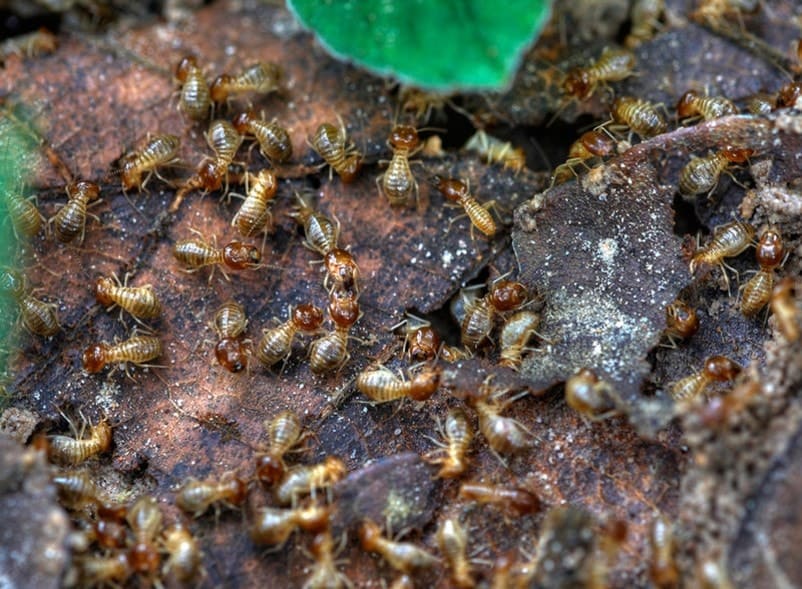
Together with cleaning your house from insects, it is important to take care of your garden. It is a complicated issue to use pesticides for your trees, but cleaning the lawn near your house will reduce the number of pests that will invade your house and trees from the ground.
Try to clean your garden and use insect repellents to keep your territory clean and, therefore, unattractive for other pests that look for the meal sources.
Step 3: Repair holes in your house
When woodpeckers start making holes in cedar siding of your housing, the loud noise might attract their partners, resulting in a more serious invasion. These holes also provide a better way for insects to invade your house that will give woodpeckers a source for feeding.
Moreover, the bigger nesting holes will eventually transform into real woodpecker nests that can attract more and more birds each year. Thus, it is important to find and repair holes made by woodpeckers quickly.
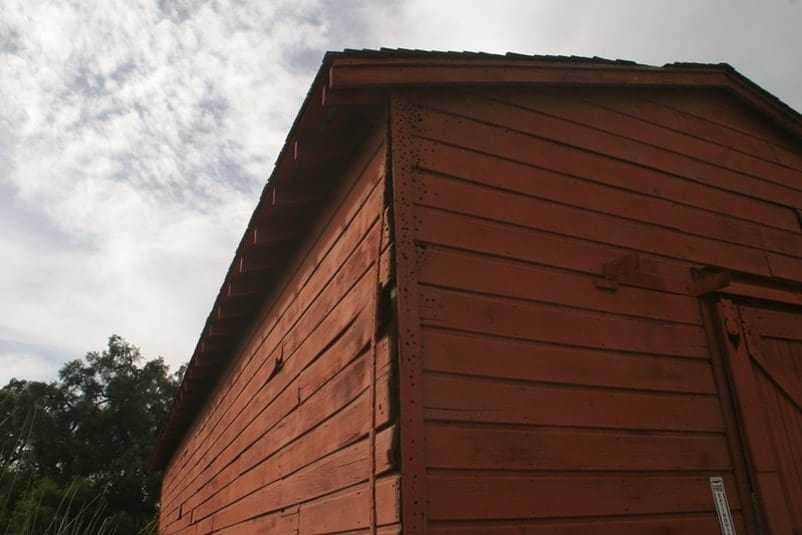
Holes repair has to be done immediately when the woodpeckers are gone. Depending on the holes’ size, you can use wood, caul, or special expandable foam to completely cover them in a short period of time. After fixing the hole, cover it with a professional woodpecker deterrent paint.
You can also use simple paints made with polyurethane that
will also prevent insects from invading your house and minimizing risks of a new woodpecker’s arrival.
Step 4: Get rid of woodpeckers
So how to deal with woodpeckers when you hear the constant drilling sound and find the signs of their infestation on your territory? There is a series of woodpecker deterrents you can apply to keep your property free from these birds.
The most simple and effective method of woodpecker elimination is scaring them away with visual deterrents. The cheapest visual bird deterrents are made of Aluminum foil that keeps the birds away. These deterrents can be stationary and moving, and the moving type is more effective because it changes its position and woodpeckers do not get used to it.
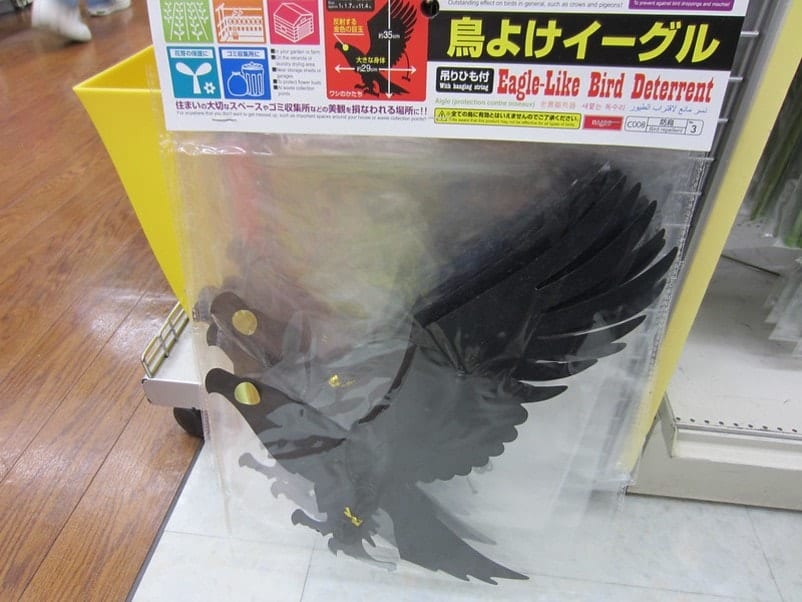
To eliminate woodpeckers from your property, it is also possible to use sound deterrents that produce special warning sounds and scare birds.
The most effective sound deterrent is an ultrasonic and electronic distress call system that produces woodpeckers’ distress call that is followed by the call of their predator to effectively scare the birds. Using this deterrent, you can be sure that the birds in the neighborhood will stay away from your house.
Tactile deterrents are affecting birds physically and thus keep them away from the place of contact. This repellent type includes sticky tapes and coating sprays. These products contain special scents that scare woodpeckers away. Using tactile, visual, and sound deterrents altogether are the most effective method of quick elimination of these birds.
In cases when woodpeckers become used to various deterrents, the most effective way to scare away woodpeckers are using bird nets around the areas you want to protect from their attacks. Bird netting prevents not only woodpeckers but all other birds from reaching the wooden areas of your property and make them look for another place to nest and feed. Properly used netting can also protect your house from similarly-sized pests attracted to this source of food.
How to prevent woodpeckers in future
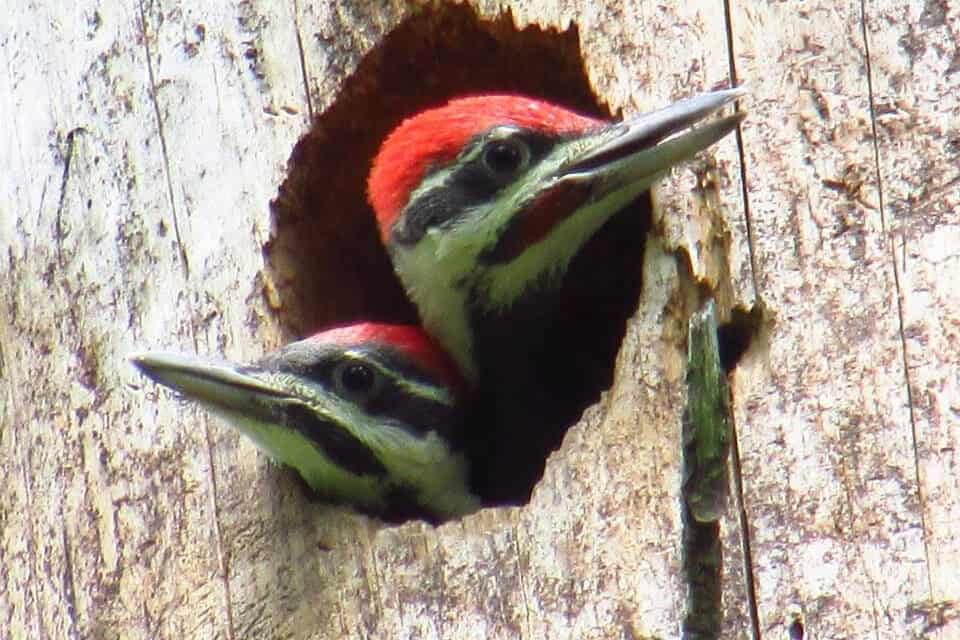
Getting rid of woodpeckers can be complicated and may take a significant amount of time, followed by repair works, fighting with insects, testing various bird repellents, etc. It is much easier to prevent these birds from coming to your property in the future.
First, you have to eliminate insects that are the source of their feeding and the major reason these birds get attracted to people’s houses. In case you have ants, bees, or termites, try to get rid of these pests as soon as possible as they are the most common insects to attract woodpeckers.
One of the best woodpecker prevention techniques for the nesting season is putting a woodpecker house near the are of their drumming to provide birds with a better alternative and stop the constant pecking of your house siding.
Preventing woodpecker damage to trees in your garden, remove large trees or branches that are close to your house to make birds feel unprotected and uncomfortable in this area. You can also provide them with better alternatives, leaving a hollow tree or stump that can be used for drumming, nesting, and making noise in the area where they won’t disturb anyone.
Support this with putting foam or muffle over the previously attacked area so the sound will be quieter and make birds move to a better drumming location.
Top 6 Woodpecker Treatments
1. Bird X Standard Bird Netting: Best Bird Proof Netting
[amazon box=”B000PUUF9G” template=”vertical” tracking_id=”how-to-get-rid-of-woodpeckers-20″ button_text=”Check price on Amazon”]
Specifications:
- Durable, Weatherproof
- Material: Mesh
- Item Weight: 5 Pounds
- Package Dimensions: 1200 x 168 x 0.1 inches
- Target Species: All Pest Birds And Other Small Animals
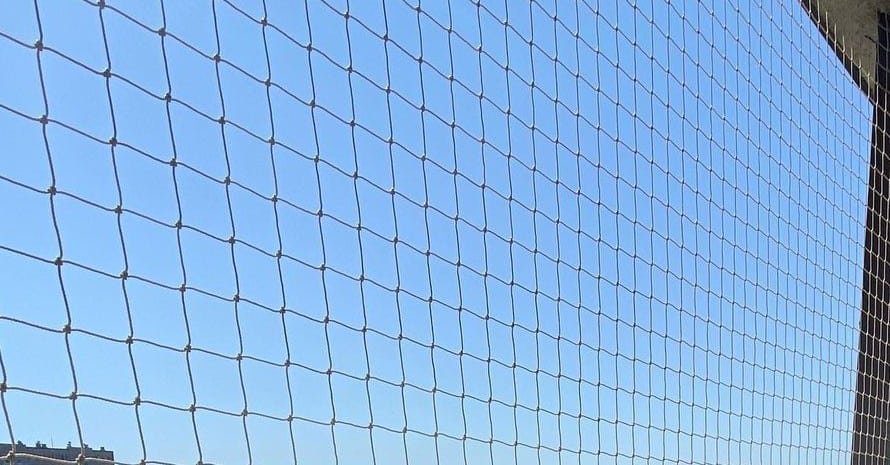
Bird-X is an experienced manufacturer of humane pest and bird control products. This US-based company was founded in 1964. Today it offers a wide range of pest control solutions that are 100% humane and environmentally friendly.
Standard bird netting is the most popular Bird-X product that creates a physical barrier for woodpeckers and other birds, keeping them away. This netting is also good protection from small-sized animals that might invade your house. It is resistant to active sunlight and moisture.
The netting is made of lightweight, pliable mesh netting that is extremely durable – you receive a 1-year warranty for any defects.
| Pros: | Cons: |
|
|
2. Birds Choice 2-Cake Pileated Suet Feeder: Best Woodpecker Feeder
[amazon box=”B001QEUEVE” template=”vertical” tracking_id=”how-to-get-rid-of-woodpeckers-20″ button_text=”Check price on Amazon”]
Specifications:
- Color: Green
- Mounting Type: Hanging Mount
- Material: Poly Lumber
- Item Weight: 2 pounds
- Package Dimensions: 8 x 3 x 23 inches
- Target Species: Finch
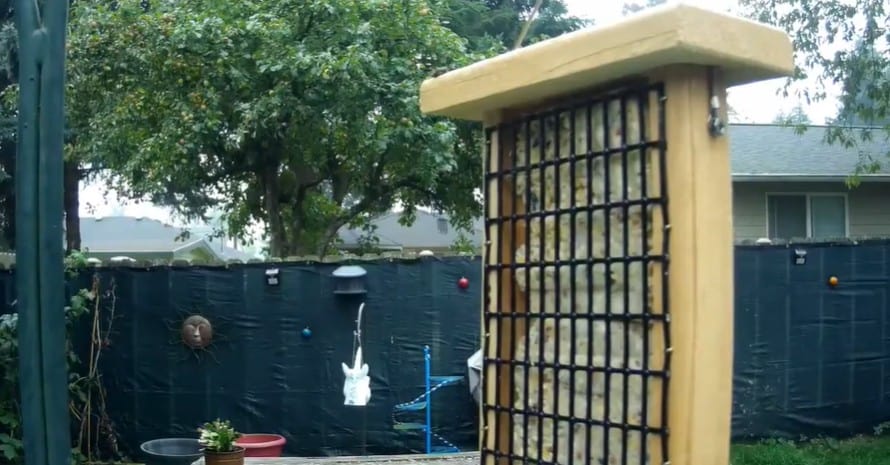
Birds Choice is a part of the Backyard Nature Products brand; it is one of the most experienced US-based manufacturers of humane bird control solutions focused on the production of various birds’ care products. Their bird’s feeders and houses are used in yards, big gardens, and even in the urban environment.
Using the 2-Cake pileated suet feeder is a great way to prevent woodpeckers damage in your property. This feeder provides woodpeckers with a better source of feeding that can as well be used for drumming. Using 2 suet cakes provides you with a longer time period between the refills, and you can also fill them with different types of meals to appeal to different birds with their preferences.
This feeder has a long tail prop to keep the feeder well-balanced, allowing bigger birds to comfortably feed. It is easy to locate the feeder, and the hanging cable is included in the set. The feeder is made of recycled poly fiber, which is very durable and resistant to cracks, splits and fading.
| Pros: | Cons: |
|
|
3. Bird-X Scare-Eye Bird Repellent: Best Woodpecker Deterrent for Garden
[amazon box=”B000QUWTS0″ template=”vertical” tracking_id=”how-to-get-rid-of-woodpeckers-20″ button_text=”Check price on Amazon”]
Specifications:
- Each Balloon Covers Up To 6,000 sq. ft.
- 3 Balloons Included Per Package (1 yellow, 1 white, 1 black)
- Item Weight: 4.96 ounces
- Package Dimensions: 16 x 16 x 16 inches
- Target Species: Birds
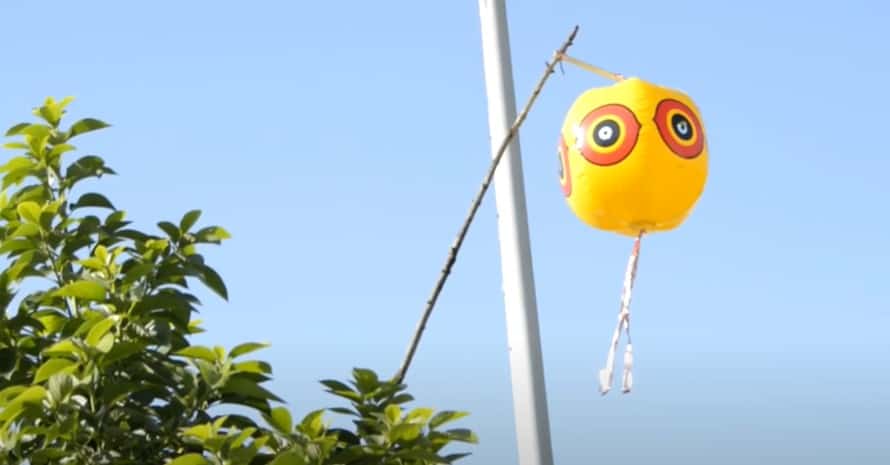
Bird-X produces a wide range of various humane solutions for bird control that are environmentally friendly. As mentioned above, this brand has been providing clients with high-quality products for 50 years, and each model is tested by experts and constantly improved with new technologies.
Eye-Scare bird repellent has a round shape, made with holographic materials in a share of predator’s eye. It is made in bright colors and can scare woodpeckers away from a significant distance – up to 6,000 square feet per balloon.
This set of 3 balloons can be used on your house siding, the rooftop, in the garden/yard, on windows, or even on the travel van or a yacht. The eyes are made of waterproof vinyl material; they are easily inflatable and resistant to the majority of possible damages.
| Pros: | Cons: |
|
|
4. Homescape Creations Owl Decoy Bird Repellent: Effective Protection Against Woodpecker Damage
[amazon box=”B01N696TIE” template=”vertical” tracking_id=”how-to-get-rid-of-woodpeckers-20″ button_text=”Check price on Amazon”]
Specifications:
- Color: Silver
- Material: Plastic, Vinyl
- Item Weight: 3.98 ounces
- Package Dimensions: 15.9 x 7.8 x 0.7 inches
- Target Species: Birds
Homescape Creations produces an effective solution for birds invasion for garden lovers and homeowners since 2016. This bard is focused on manufacturing effective products that will help you save time and effort on birds’ control.
With Owl Decoy Bird Repellent, you can effectively protect your property, using a combination of visual and sound repellent. This product produces refracting light, scaring sound, and unpredictable motion. It is easy to hang it; it is resistant to sunlight and made of eco-friendly materials.
This vinyl repellent won’t harm birds and can even prevent the window strikes. In case you are not fully satisfied with the product, manufacturers will make a full refund.
| Pros: | Cons: |
|
|
5. Taurus SC 20 Termiticide Generic Termidor: Best Termiticide to Keep Woodpeckers Away
[amazon box=”B007G2QPAY” template=”vertical” tracking_id=”how-to-get-rid-of-woodpeckers-20″]
As one of the reputable brands in pest control, Taurus constantly develops new effective products that help you stop an infestation of various insects that invade your territory. Their products are mostly used by licensed professional pest fighters, but some of them are available for well-thought private use.
SC 20 termiticide will help you destroy the key woodpecker meal source – pests. This non-repellent insecticide is made for effective termite treatment. It also treats ants, Asian lady beetles, ants, spiders, house crickets, cluster flies, box-elder bugs, cockroaches, paper wasps, and other pests effectively.
Destroying the key reason for woodpecker invasion, you will force them to get away from your property once and forever. This product can eliminate termite colonies in 3 months, and it takes a few weeks for it to eliminate ants colonies. This termiticide is an excellent territory treatment for outdoor use.
| Pros: | Cons: |
|
|
6. Bird B Gone Woodpecker Deterrent Kit: Best Woodpecker Deterrent for House and Garden Use
[amazon box=”B002FNPZ0A” template=”vertical” tracking_id=”how-to-get-rid-of-woodpeckers-20″]
Bird B Gone is the leading manufacturer of pro-level bird control products, recognized by both private clients and professional pest control workers in all regions of the world. Their extensive life of various bird deterrents helps in solving bird problems for commercial, industrial, and residential settings, providing clients with the right product and effective advice on its installation.
Woodpecker deterrent kit has visual deterrents that help you get rid of these pests in a humane way. The kit includes a Predator Eye Balloon, a roll of Flash Tape, and two brackets for easy installation. They are made with non-chemical materials that won’t harm a feather. It appeals to the bird’s sense of danger, making them avoid the dangerous area.
If you don’t know how to stop woodpeckers attacking your house – blow up and assemble the deterrent balloon. After that attach it to the long balloon bracket, take two smaller flesh tape brackets and attach it to the balloon sides, tying the tape stripes to them. The ballon and tape will move on the wind, scaring woodpeckers away.
| Pros: | Cons: |
|
|
The Most Commonly Asked Questions About Effective Woodpecker Removal
To scare away woodpeckers from your property, it is important to study their feeding and nesting habits, where they prefer to nest, what locations they avoid, and what are their natural predators. Here are the key questions that will provide you with more information about these pests.
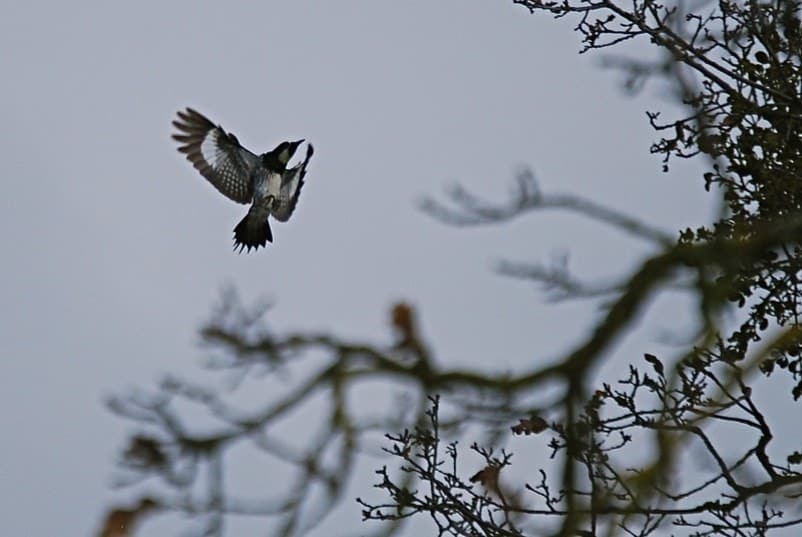
Do woodpeckers eat termites?
Wood-boring insects are woodpeckers’ favorite food, so these birds do eat termites. Apart from termites, woodpeckers also feed on bees, ants, and grabs.
[su_note note_color=”#e5e2d4″]Related post: How to Keep Hawks Away from Chickens [/su_note]
Are woodpeckers afraid of owls?
Owls are one of the woodpeckers’ natural predators. Thus, they are afraid of owls and try to avoid territories of their possible habitat or hunting.
Does woodpecker feed on house mean termites?
Although woodpeckers might get attracted to your property because of thermites that live inside the wooden siding of your house, this is not the only reason these birds get attracted to it. They might be hunting for other insects, such as ants or bees; they might also build their nest on the house or try to attract partners using the wooden siding.
Do windchimes scare woodpeckers?
Windchimes produce dulcet sounds that can irritate woodpeckers and other birds. Windchimes can be used to scare woodpeckers away from your property, as they fool woodpeckers into thinking a predator is around.
What do woodpeckers hate?
Woodpeckers hate bright light, so shiny objects can scare them away. They also try to avoid their natural predators, such as owls and eagles, so imitating predators’ shouting or setting up a pretend predator is a good way to get rid of woodpeckers.
[su_note note_color=”#e5e2d4″]Related post: How to Get Rid of Geese [/su_note]

Choosing the Best Method to Deter Woodpeckers from House
Keeping your house free from woodpeckers damage is not an easy task. You will have to pay extra attention to these birds, find out the reasons for their invasion, and learn more about suitable methods that will help you scare them away once and forever.
There is a series of humane, eco-friendly, and effective ways to deter woodpeckers from house and garden. For example, visual, sound, and tactile deterrents, but my favorite method is using a special netting that can effectively protect your property from all types of birds.
What is your perfect way to solve a woodpecker problem? Please, share your experience in the comments.
References:
- Why Do Woodpeckers Like To Hammer On Houses? And What Can I Do About It? (All About Birds):
https://www.allaboutbirds.org/news/why-do-woodpeckers-like-to-hammer-on-houses-and-what-can-i-do-about-it/ - External characteristics of houses prone to woodpecker damage(University of Nebraska):
https://digitalcommons.unl.edu/cgi/viewcontent.cgi?article=1030&context=hwi - Preventing Woodpecker Damage (Colorado State University): https://extension.colostate.edu/docs/pubs/natres/06516.pdf
- Woodpeckers Making Holes in Cedar Siding (PennState Extension):
https://extension.psu.edu/woodpeckers-making-holes-in-cedar-siding - Preventing Woodpecker Damage to Trees(Cororado State University): https://planttalk.colostate.edu/topics/wildlife-issues/2304-preventing-woodpecker-damage-trees/

